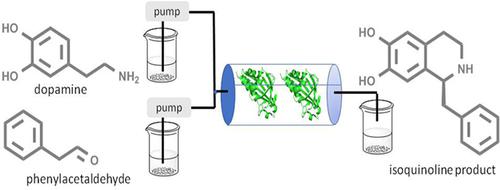当前位置:
X-MOL 学术
›
Biotechnol. J.
›
论文详情
Our official English website, www.x-mol.net, welcomes your
feedback! (Note: you will need to create a separate account there.)
Library of Norcoclaurine Synthases and Their Immobilization for Biocatalytic Transformations
Biotechnology Journal ( IF 3.2 ) Pub Date : 2017-12-04 , DOI: 10.1002/biot.201700542 Horst Lechner 1 , Pablo Soriano 1 , Roman Poschner 1 , Helen C Hailes 2 , John M Ward 3 , Wolfgang Kroutil 1
Biotechnology Journal ( IF 3.2 ) Pub Date : 2017-12-04 , DOI: 10.1002/biot.201700542 Horst Lechner 1 , Pablo Soriano 1 , Roman Poschner 1 , Helen C Hailes 2 , John M Ward 3 , Wolfgang Kroutil 1
Affiliation

|
Norcoclaurine synthases (NCS), catalyzing a Pictet–Spengler reaction in plants as one of the first enzymes in the biosynthetic benzylisoquinoline pathway, are investigated for biocatalytic transformations. The library of NCS available is extended by two novel NCSs from Argemone mexicana (AmNCS1, AmNCS2) and one new NCS from Corydalis saxicola (CsNCS); furthermore, it is shown that the NCS from Papaver bracteatum (PbNCS) is a highly productive catalyst leading to the isoquinoline product with up to >99% e.e. Under certain conditions lyophilized whole Escherichia coli cells containing the various overexpressed NCS turned out to be suitable catalysts. The reaction using dopamine as substrate bears several challenges such as the spontaneous non-stereoselective background reaction and side reactions. The PbNCS enzyme is successfully immobilized on various carriers whereby EziG3 proved to be the best suited for biotransformations. Dopamine showed limited stability in solution resulting in the coating of the catalyst over time, which could be solved by the addition of ascorbic acid (e.g., 1 mg ml−1) as antioxidant. Norcoclaurine synthases (NCS) catalyze a Pictet–Spengler reaction of, for example, dopamine with various aldehydes. A library of norcoclaurine synthases is set up and investigated including novel enzymes from Argemone mexicana, Corydalis saxicola, and Papaver bracteatum (PbNCS), whereby the latter is a highly productive catalyst leading to the isoquinoline product with up to >99% e.e. The PbNCS enzyme is successfully immobilized on various carriers whereby EziG3 proved to be the best suited for biotransformations.
中文翻译:

Norcoclaurine 合成酶库及其用于生物催化转化的固定化
Norcoclaurine 合酶 (NCS) 作为生物合成苄基异喹啉途径中的第一个酶之一,在植物中催化 Pictet-Spengler 反应,用于生物催化转化。可用的 NCS 库由Argemone mexicana (AmNCS1、AmNCS2) 的两个新 NCS 和Corydalis saxicola (CsNCS) 的一个新 NCS 扩展;此外,表明来自罂粟(PbNCS) 的 NCS 是一种高产催化剂,导致异喹啉产品的 ee 高达 >99% 在某些条件下冻干整个大肠杆菌含有各种过表达 NCS 的细胞被证明是合适的催化剂。使用多巴胺作为底物的反应面临一些挑战,例如自发的非立体选择性背景反应和副反应。PbNCS 酶成功地固定在各种载体上,由此证明 EziG3 最适合生物转化。多巴胺在溶液中表现出有限的稳定性,导致催化剂随着时间的推移被涂层,这可以通过添加抗坏血酸(例如,1mg ml -1)作为抗氧化剂来解决。Norcoclaurine 合酶 (NCS) 催化多巴胺与各种醛的 Pictet-Spengler 反应。建立并研究了一个去甲克劳林合成酶文库,包括来自墨西哥 Argemone的新型酶,Corydalis saxicola和Papaver bracteatum (PbNCS),后者是一种高产催化剂,可产生高达 >99% ee 的异喹啉产品 PbNCS 酶成功地固定在各种载体上,由此证明 EziG3 最适合生物转化。
更新日期:2017-12-14
中文翻译:

Norcoclaurine 合成酶库及其用于生物催化转化的固定化
Norcoclaurine 合酶 (NCS) 作为生物合成苄基异喹啉途径中的第一个酶之一,在植物中催化 Pictet-Spengler 反应,用于生物催化转化。可用的 NCS 库由Argemone mexicana (AmNCS1、AmNCS2) 的两个新 NCS 和Corydalis saxicola (CsNCS) 的一个新 NCS 扩展;此外,表明来自罂粟(PbNCS) 的 NCS 是一种高产催化剂,导致异喹啉产品的 ee 高达 >99% 在某些条件下冻干整个大肠杆菌含有各种过表达 NCS 的细胞被证明是合适的催化剂。使用多巴胺作为底物的反应面临一些挑战,例如自发的非立体选择性背景反应和副反应。PbNCS 酶成功地固定在各种载体上,由此证明 EziG3 最适合生物转化。多巴胺在溶液中表现出有限的稳定性,导致催化剂随着时间的推移被涂层,这可以通过添加抗坏血酸(例如,1mg ml -1)作为抗氧化剂来解决。Norcoclaurine 合酶 (NCS) 催化多巴胺与各种醛的 Pictet-Spengler 反应。建立并研究了一个去甲克劳林合成酶文库,包括来自墨西哥 Argemone的新型酶,Corydalis saxicola和Papaver bracteatum (PbNCS),后者是一种高产催化剂,可产生高达 >99% ee 的异喹啉产品 PbNCS 酶成功地固定在各种载体上,由此证明 EziG3 最适合生物转化。













































 京公网安备 11010802027423号
京公网安备 11010802027423号